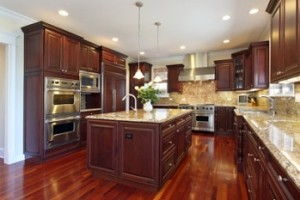 Many people want hardwood floors in their home, and for good reason. Hardwood floors are timeless; they have a natural beauty that gives a look of warmth and elegance to any room in the house, regardless of whether your style is traditional or contemporary.
Many people want hardwood floors in their home, and for good reason. Hardwood floors are timeless; they have a natural beauty that gives a look of warmth and elegance to any room in the house, regardless of whether your style is traditional or contemporary.
Hardwoods can increase the value of your home, as they attract many buyers. They are soft on your feet, retain warmth, and are a great option for allergy sufferers, as they do not collect and harbor the amount of dust and other allergens that other floors may.
Most wood floors today still come from either red or white oak, but the options are endless with a huge range of species to choose from. When it comes to wood floors in the kitchen, however, there are somewhat different rules to follow. So, when you are shopping for wood flooring, make sure to let your designer know you plan on installing them in the kitchen, and take into account their recommendations.
Special considerations
There are a few things to keep in mind when picking out wood for a floor in a high traffic area such as the kitchen.
- Water damage – The kitchen floor is going to get wet at some point in time, whether your dishwasher leaks while you are at work, or the pipe under the kitchen sink decides to burst. This can cause warping or buckling, and over time can mean eventually replacing parts of the floor.
- Replacing boards – Even if it is simply a small area that has been damaged, and you replace those particular boards, the entire floor has to be sanded and refinished to keep a uniform look – which can be very pricy. On the flip side of the coin, hardwood floors can be sanded and refinished multiple times, and will last for many years to come.
- Noise levels – Hardwood floors tend to bring the general noise level up a notch, so you may want to invest in area rugs.
- Temperature changes – Wood is also known to expand and contract with temperature changes, so be conscious of the climate you live in.
Hard or Soft
Hardwood Floors are typically categorized as being either “hard” or “soft.” For the hard, you have species such as oak, maple, ash, birch, mahogany and sometimes cherry. Some of the more popular soft woods include pine, fir, cedar and cypress.
Since the kitchen is usually a high traffic area, it is going to experience shoe heels, pets, drops, drips, spills, grit, grime, dirt…you get the picture. Many people say “hard” woods are the way to go in a kitchen to lessen some of the results of these daily life occurrences, as they are stronger and more durable. Try to keep mindful of damage potentials, because when the dents and scratches do come, they are pretty obvious.
Because of this, others would argue that soft woods are a better route. They give more of a rugged distressed feel and look; which only becomes more beautiful over time with each scratch, dent, spill and stumble. If you have kids or pets, or just generally don’t want to tip-toe around the house; this can be a great choice. Soft woods are a little more environmentally friendly, as they tend to grow quicker; and the price range comes in a little less than the hard wood species.
The decision is ultimately up to you and your designer, so make sure you take into account your personal situation – kids, house rules, accident-proneness, etc. Take care of your hardwoods, and they’ll be beautiful for years to come.

Recent Comments